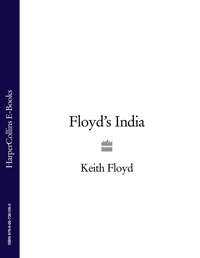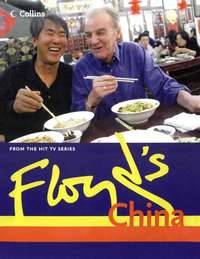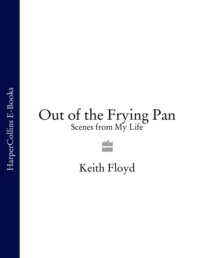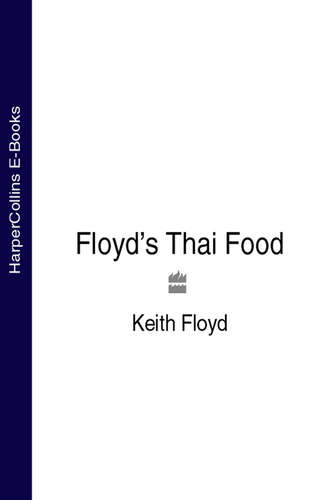
Полная версия
Floyd’s Thai Food
The next day, we took a terrifyingly fast, bouncing, long-tailed boat ride up the river past rickety little shacks standing perilously on stilts, and past the wats, all the while Tony the photographer shooting away like mad.
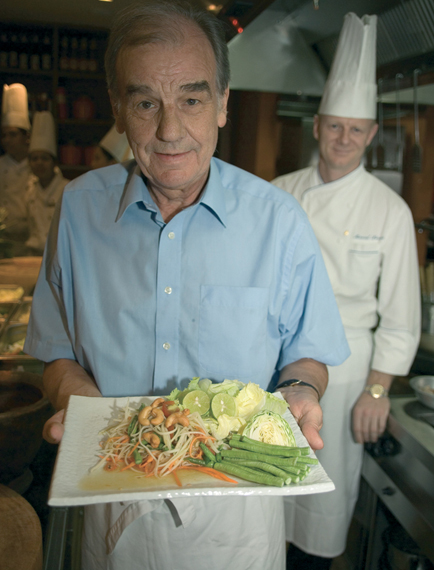
I rustled up this plate of refreshing papaya salad with my old friend Marcel Nosari, executive chef of the Intercontinental Hotel.
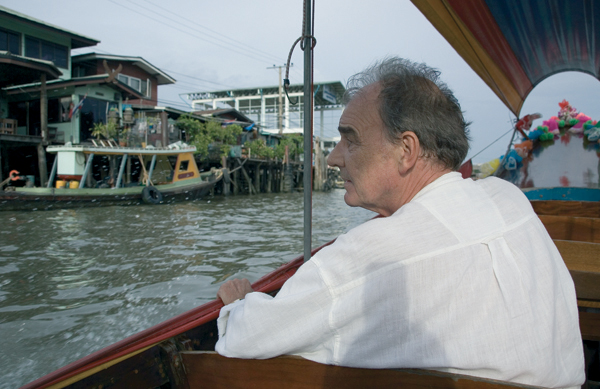
A trip down the Chao Phraya River, Bangkok.
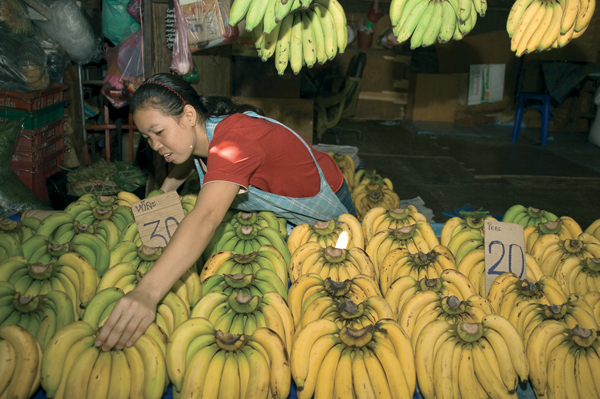
The bananas are creamy and cheap.
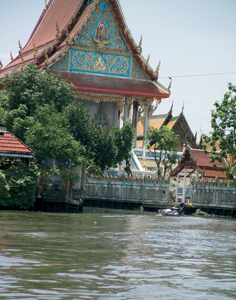
The colourful Chao Phraya riverbank.
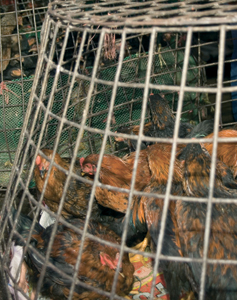
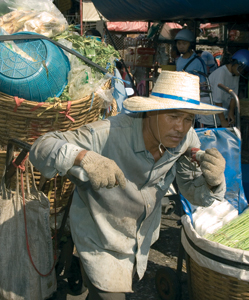
Scenes from Klong Toey Market, Bangkok.
The city streets were heaving with stalls, food hawkers, errand boys carrying huge sacks of rice on their heads, women with huge wicker baskets filled with fruit and vegetables, open-air butchers, and fresh chickens crowded into igloo-shaped bamboo cages. But, Mark and Mike say it is time for us to go back to Phuket. We had to fly back there to meet the architects and designers who, I hope, are going to follow my suggestions for the creation of Floyd’s Restaurant at the Burasari Hotel in Patong. We spent three days poring over plans, discussing menus and staff requirements, and although it is hard work starting any kind of enterprise like that (especially when you have to be au fait with Thai time), if you approach it gently as, by the way, everything that you do in Thailand should be approached, you will see why one smile makes two.
Keith Floyd
Burasari Hotel
Patong
Phuket
Thailand
2005
Tastes and tools of the Thai trade
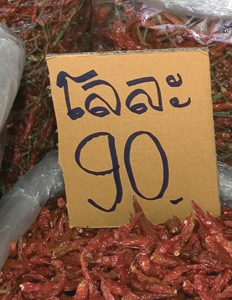
Thailand is a magical and exotic country formerly known as Siam, with a famed royal family who endure and are adored by the Thais to this day, and I have been very lucky to have travelled north, south, east and west since I first went there in 1984. Thailand was never invaded or colonized by a European power. It is true there were skirmishes with Burma, but in the grand picture they are, today, completely insignificant. More important, though, are the gastronomic invasions that have taken place, which the Thais have welcomed, embraced and fused into their own rich, culinary heritage.
In Thai cuisine you will find the influences of Laos, Cambodia, Burma, Malaysia and, of course, China. But perhaps the most significant invasion came not from the region but from South America when, in the sixteenth century, Portuguese merchant men introduced to Thailand the signature taste of chillies.
Chillies and Thai cooking are symbiotic. From the explosively dynamite hot, tiny bird’s eye chillies, right through the gamut of this exquisite vegetable to large peppers, green, yellow and red, chillies are extremely important to Thai cooking, and make vibrant displays in huge wicker baskets all over the country. Whether chopped fresh and popped into dishes or compounded into pastes, they are indispensable. Another vital ingredient is fish sauce, which is used throughout South East Asia instead of salt. Tiny fish, often anchovies, are laid out on the beach in their thousands and allowed to dry before being put into vats and left to ferment; incidentally, the Romans had a similar sauce that was called liquamen.
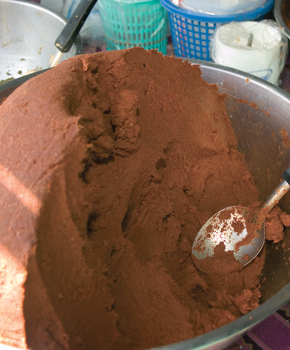
Red chilli paste is available ready-made from the markets.
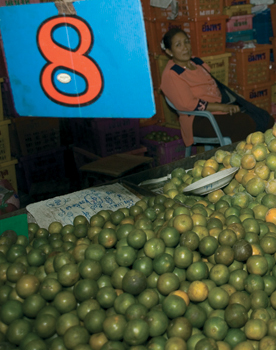
Juicy, aromatic limes.
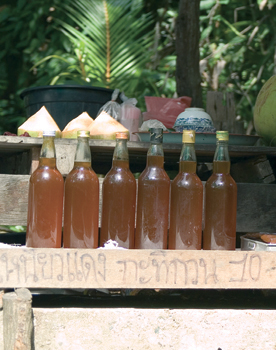
Local honey.
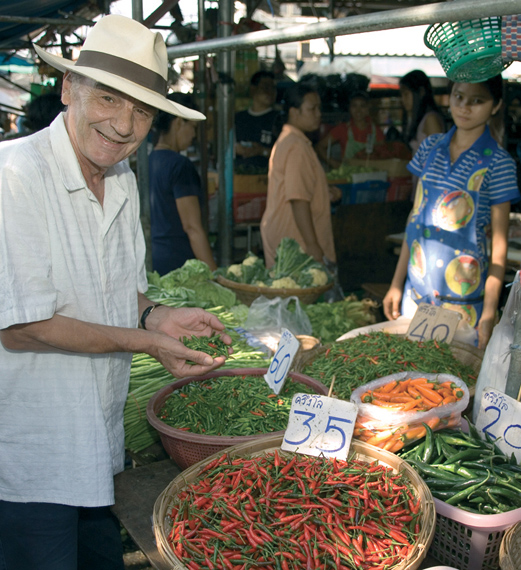
The Thais just can’t get enough fresh and dried chillies.
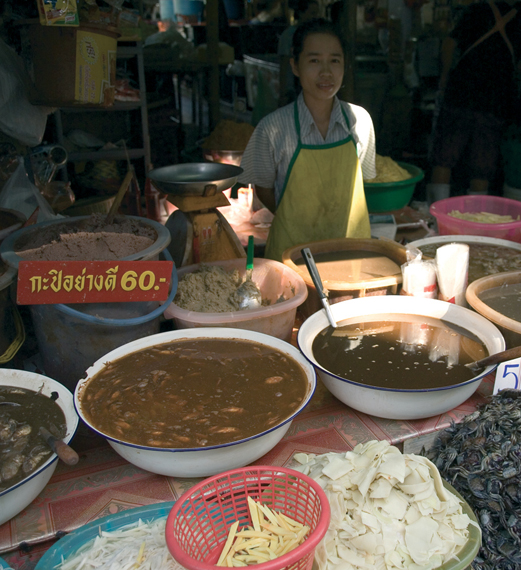
Bowls of fermented fish at Klong Toey Market.
The explosive tastes of Thai food are also enhanced by the citric and sour flavours provided by lime juice, lemon grass, kaffir lime leaves and tamarind, and are then softened with either coconut water or coconut milk and the indispensable masses of fresh basil, mint and coriander – just loosely ripped up and chucked onto the top of any dish, they give a crunchy freshness and combat the fiery tastes.
In the north and north-west of Thailand, on the Burmese border, in the lush forests and jungles of places like Mae Hong Son and Chiang Mai, where wonderful rivers flow and working elephants bathe, you will find fiercely hot curries and salads. Even in the twenty-first century, the lore of the hunter-gatherer is reflected in the leaves and vegetables that are used for these salads – very often served with a warm dressing of chillies, fish sauce, palm sugar and lime juice – and in the very distinctive cooking of this region. Obviously, Bangkok, an international city, will cook, display and sell the delights of the whole country and, of course, the dreaded McDonald’s, Pizza Hut and all the other appalling effects of American gastronomic imperialism.
As you progress south towards Malaysia, you will, as you do in Kerala in southern India, enter the world and the land of the coconut – so important in the rich, creamy, spicy, subtle, fragrant curries and the delicate, but deliciously sweet puddings.
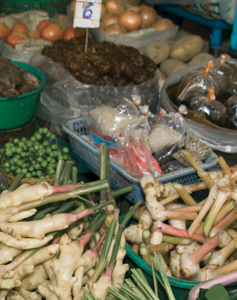
A few of the many vegetables used in Thai cookery.

Preparing palm sugar.
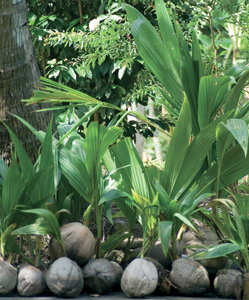
Coconuts awaiting collection by boat at the Damnoen-Saduak floating market.
In this slender volume, I am saddened that I do not have the space to eulogise at length over the subtleties and fundamentals of Thai cooking, so here, in a plain and straightforward way, are some brief, but important guidelines:
Basic utensils
Since in Thailand most of the cooking is done in huge aluminium vats over charcoal-fired barbeques, or in woks, or even, such as is the case with the famous sticky rice, cooked in bamboo tubes about 7.5 cm/3 inches in diameter (or baskets) over a low charcoal fire, it is going to be quite difficult, in our highly sophisticated Western kitchens, to replicate the amazing flavours that these simple heat sources create.
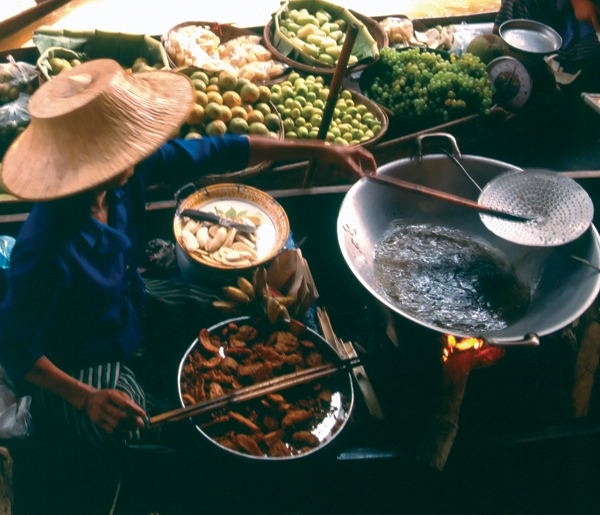
Cooking up a storm at the floating market.
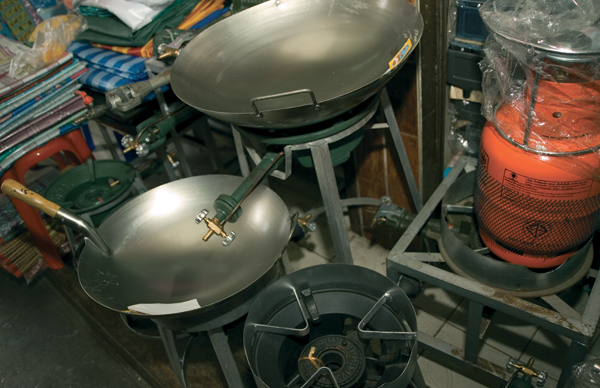
The indispensable wok, for sale at Klong Toey Market.
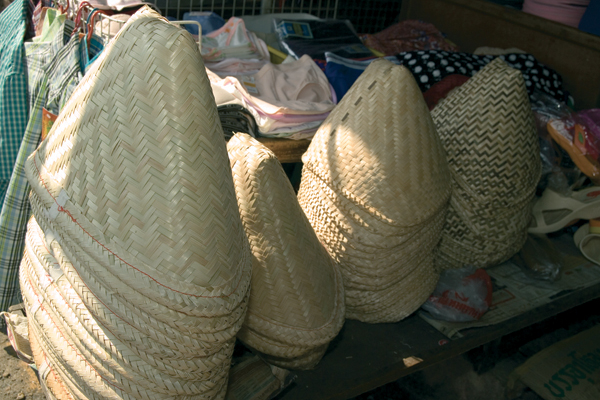
These baskets are used for cooking sticky rice.
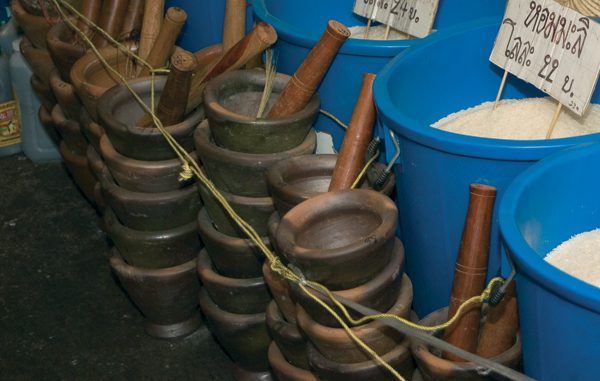
Sticky rice for sale, alongside wooden pestles and mortars.
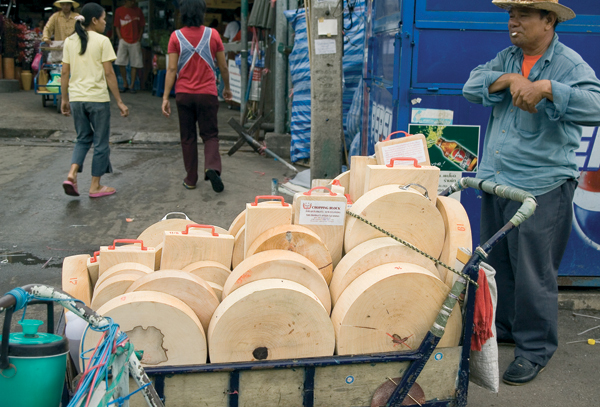
The chopping boards are sturdy and need to be to withstand all the use they’re put to.
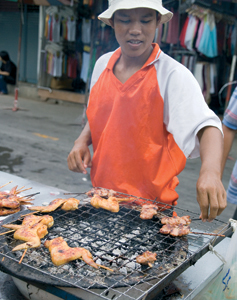
Unidentified frying objects.
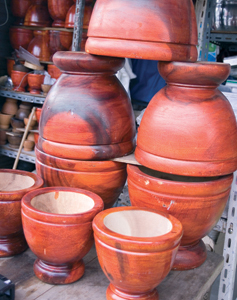
The colours and shapes of turned wood are very attractive.
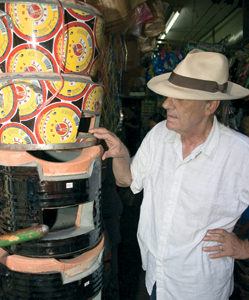
Charcoal-fired cooking stoves.
Since a lot of Thai cooking is done in woks, it is good to have a high-flamed gas stove, or, indeed, a powerful bottled-gas camping stove – you can cook outside when it is not raining. You will need a couple of woks, a small one and a large one. If you have an electric cooker, buy flat-bottomed woks; if you have a fiery gas cooker, buy round-bottomed woks. You need a large pan for deep-fat frying, with a wire basket for straining. You need a couple of large bamboo steamers with lids and a suitably large pan the same size as the steamer so that it can sit on top of the boiling water. I do think an electric rice cooker is a really brilliant idea. Not only does it mean you will cook rice perfectly every time, but the rice will stay hot without spoiling for up to a couple of hours, and since the essence of Thai cooking is rice placed in the centre of the table, while everything else is just an accompaniment, this means that you can serve a small portion of rice time after time with each successive dish. For the serious-minded and those with ample time, a large, heavy pestle and mortar is de rigueur for preparing your pastes and salads. For those with less time, invest in an electric food processor. You will need sensible tongs to turn and lift the food; you will need wooden spoons or spatulas for stir-frying; a set of very sharp knives, and some substantial chopping boards. Should you find yourself on holiday in Thailand, you will notice in the markets that their chopping boards are mostly circular and cut from the trunk of a tree, upon which they deftly chop everything from chickens to vegetables with an extremely sharp cleaver – not for them a posey little knife rack filled with blunt knives acquired from some readers’ offer in a magazine.
Ingredients
The Thais relish virtually every kind of green vegetable that there is, from Morning Glory, which is a form of lily pad, through to long green beans called Snake Beans. They can be between 30, 38 or 45 cm/12, 15 or 18 inches long. If you can find them, well and good, but I have substituted them with French green beans, a.k.a. haricot vert, which need to be topped and tailed and cut according to the recipe. They are a very good alternative.

Galangal or Thai ginger.
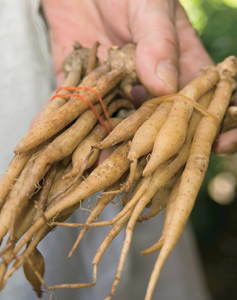
Krachai, a relative of ginger root, but milder than ginger or galangal.
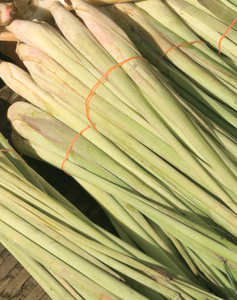
Lemon grass.
Where recipes call for shallots or onions, please use red shallots and red onions.
Many Thai dishes require some sugar. Unless otherwise stated, this should be palm sugar or soft Demerara (or soft light brown sugar).
The basic dark green leaves used in Thai cooking are known as Chinese kale. In good Asian stores this is known as Gai larn. For ease of accessibility, I have substituted pak choi or choi sum. You could, of course, also use spinach.
Thais favour galangal over fresh root ginger because it is slightly sweet and more tender than ginger, but either can be used. Another great favourite, and member of the ginger family, is fresh turmeric root, a little yellow-ochre knobbly root about the size of your little finger. You might find this in good Asian stores.
When using lemon grass, remove the outer leaves and use the bottom 15 cm/6 inches of the stalk (or the white part only as specified). If you can’t get lemon grass, use dried lemon grass (add a little extra for flavour), or the zest of 1 lemon (zest from 1 lemon = 2 stalks lemon grass).
An essential ingredient for cooking Thai food is kaffir lime leaves. However, if you can’t obtain them, 1 tablespoon lime or lemon zest = c.6 kaffir lime leaves. If you are substituting dried leaves for fresh, they are much less flavourful, so use twice as many as the recipe calls for and, if possible, add dried leaves to the recipe earlier than you would fresh in order to extract the maximum amount of flavour.
Green curries, in particular, benefit from a few fresh green peppercorns; however, if they are difficult to find, buy green peppercorns pickled in brine, rinse them well and drain them. They make a fair substitute. The ones from Madagascar are particularly good.
Most Thai curries use baby aubergines the size of a large pea. They may be difficult to source outside of London, Manchester, Bradford and Leeds and other large cities, although you may find them frozen. If you are unable to find them buy small aubergines, cut them into 1 cm/1/2 inch cubes and leave the skin on.
Where white vinegar is required, try to buy first a) white coconut vinegar, b) rice vinegar, or c) white wine vinegar.
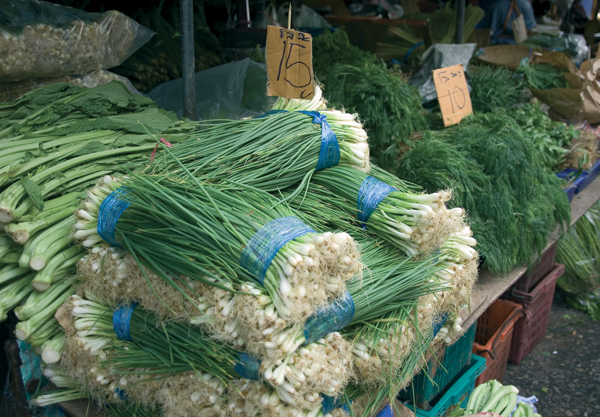
Not for the Thais mean little bunches of spring onions from the supermarket. Their leaves and herbs are super-fresh.
For frying oils, use coconut oil for stir-frying, if possible, and good-quality vegetable, corn or sunflower oil for deep-frying.
Thai curries differ dramatically from Indian ones. The Indian kitchen largely uses dried and often toasted spices. The Thai kitchen uses fresh herbs and spices, often toasted, to make a ‘wet’ curry paste. Thai curries can be severely hot, so take care with the chillies, especially the small bird’s eye chillies. These tiny little things are absolute dynamite. As a rule of thumb, the seeds are the hottest part of the chilli and the pith the next hottest, and most chillies are fairly mild if these elements are removed – I leave it to you.
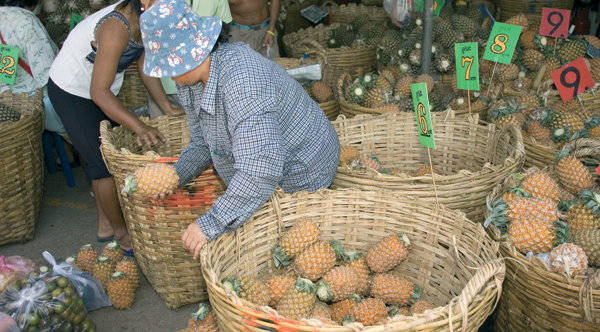
What these pineapples lack in size they make up for in sweetness.
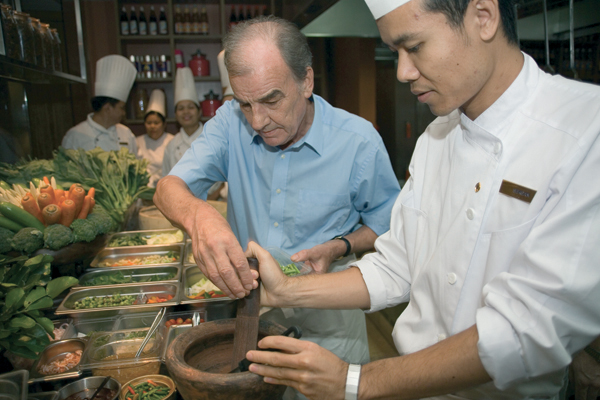
Pounding the spices for a curry paste at the Intercontinental Hotel.
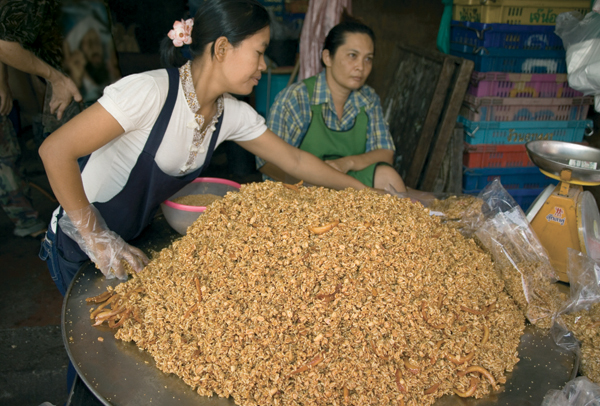
These mixed nuts are sold ready-chopped.
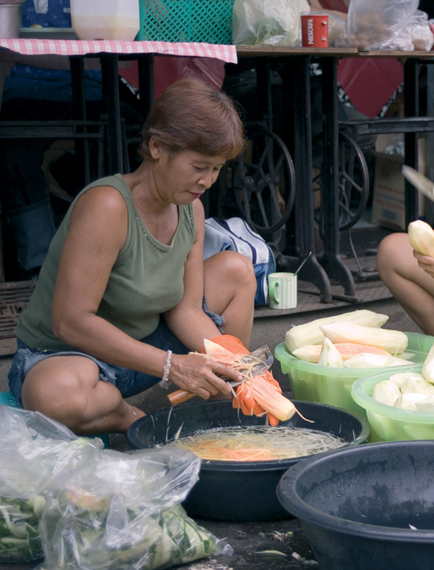
A trader prepares her wares at the Chatuchak Market.
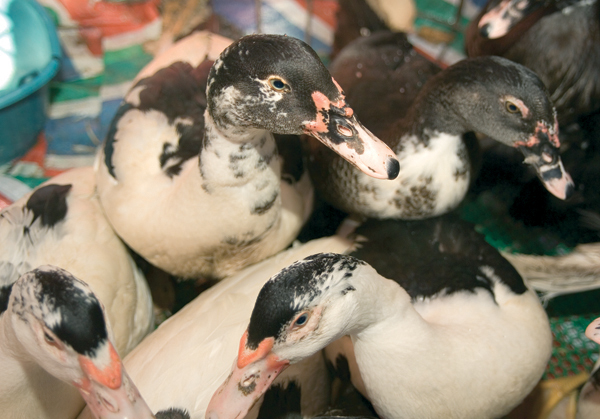
These birds will be despatched for you at the market, or you can do the deed yourself at home.
Let’s put Thai curry paste on the line! Are you blender-lazy or pestle-proud? Traditionally, Thai curry pastes are made with a pestle and mortar. The ingredients are added gradually in the given order, starting from the hardest and the driest to the softest and the wettest, with each being reduced to a pulp before the next is added. As the ingredients are pounded, they release their fragrance and the balance of the paste can be sensed in the aroma and can be adjusted while the paste is being made. My recipes for curry pastes must be used just as a guide. They are not written in stone, it is not gospel and it is not rocket science. Sometimes, for instance, you may find that the shallots or the galangal you are using are sharper than usual, so touch, taste, smell and adjust. Needless to say, making a curry paste by hand is time-consuming, onerous and messy, but the result is genuinely superior – both in texture and balance of flavours – to one made in a food processor. Pastes made by hand have an integrity and intensity of flavour and the loving serenity that no machine can ever equal. However, these days, when everyone seems to lead such busy lives, you’ll probably want to use the food processor.
One of the most agreeable things in fine Thai restaurants is the sight of serene but smiling ladies in traditional costume sitting cross-legged on a bench-cum-table carving fruit and vegetables into exquisite shapes to garnish so many Thai dishes. They spend years acquiring their exquisite art and it is a joy to watch their patient skill. If you have the time and the patience, you may wish to emulate them.
The Thai table and quantities
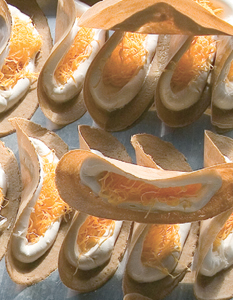
Eating Thai food (which, by the way, is not served as a procession of starter, vegetable, main course and pudding) is meant to be a sociable affair where all the dishes are presented as they are cooked. Soups come in a large bowl and are eaten throughout the meal, not before it, and, certainly in Thailand, the food is not necessarily served hot. Some food is placed on platters, passed around and eaten with a spoon and fork, not with chopsticks.
For some mad reason, food editors seem to require measurements, weights and cooking times all in precise detail. Now, most food in Thailand, and indeed throughout Asia, is cooked outside on the simplest of equipment by people who have never read a cookery book or watched a TV cookery programme, they just cook instinctively. If you have only a small amount of chicken, then you have only a small amount of chicken, so you stretch the meal with rice or noodles. Please be warned that all the measurements, cooking times and weights in this book are absolutely approximate. No Thai person would ever dream of weighing out 275 g/10 oz of noodles or 225 g/8 oz of rice.
Anyway, that is my lecture over. I hope it has been helpful!
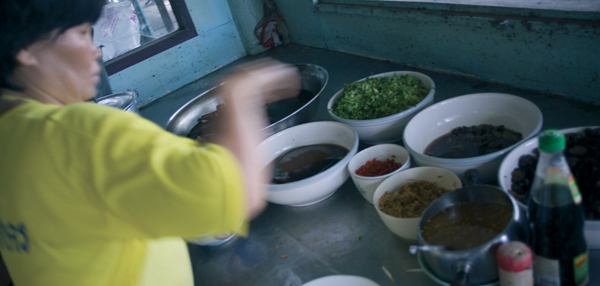
Preparing the ingredients for a curry at the famous Pet-Palo-Huahaheng Duck Restaurant.
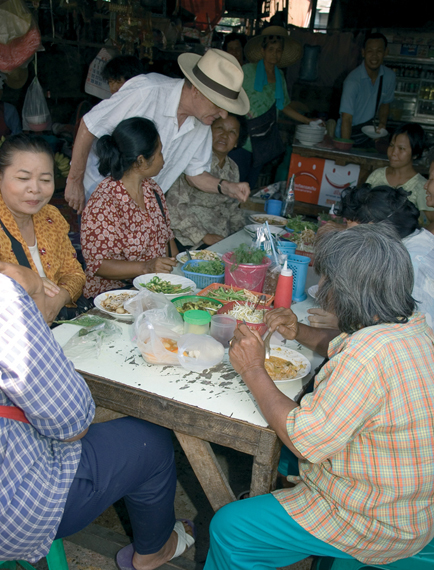
These ladies were happy for me to try their food.
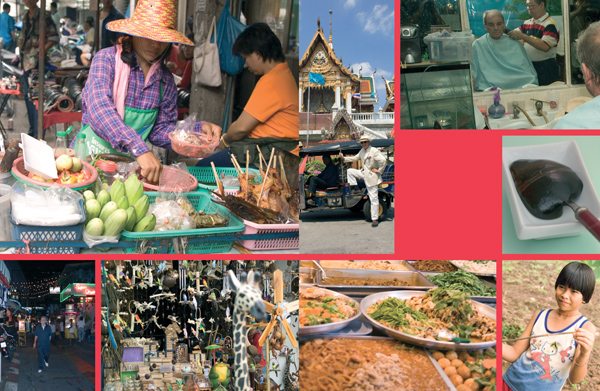
Sauces, pastes and dips
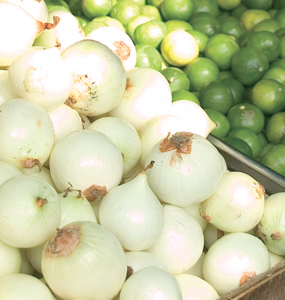
White onions.
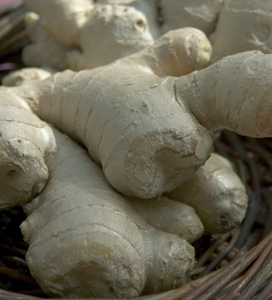
Fresh root ginger.
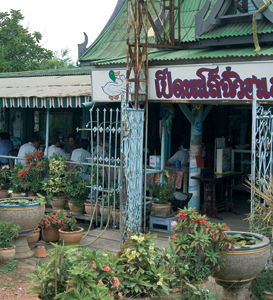
Pet-Palo-Huahaheng Duck Restaurant.
The Thai people like their food hot and some of the world’s hottest chilli peppers are grown in Thailand. So, as you would expect, chillies play an important part in their curry sauces, pastes and dipping sauces.
These sauces and pastes are an indispensable part of Thai cooking, and home-made ones are well worth the effort. Many of the pastes can also be used as marinades, dipping sauces or to flavour a simply cooked bowl of rice or noodles. Chilli sauces are also used in salads.
Regional varieties are found throughout Thailand, but the basic curry pastes combine dry spices and fresh herbs with ginger, garlic, chillies and citrus juice and leaves.
Dipping sauces provide a contrast to the food they’re serve with – cooling dips for hot and spicy dishes, or fiery dips to accompany less highly flavoured food.
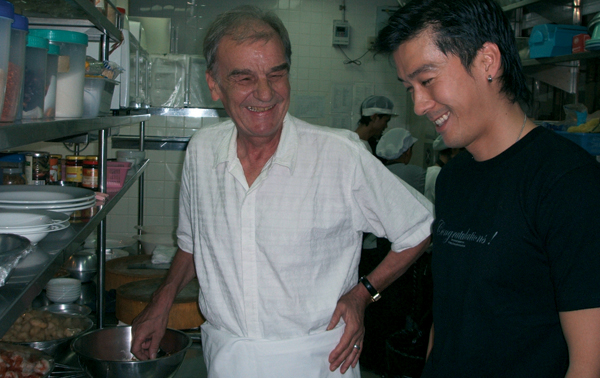
Khun Phol Tantasathien, owner of the Spring Restaurant, was great company.
Curry powder
1 tablespoon cloves
3 tablespoons coriander seeds
3 tablespoons cumin seeds
1 tablespoon fennel seeds
3 tablespoons dried chilli flakes
3 tablespoons turmeric powder
2 tablespoons ground ginger
2 teaspoons white peppercorns
4 cardamom pods
1 Heat a wok or heavy-based frying pan and, without adding any oil, dry-roast the cloves, coriander, cumin and fennel seeds for 40–50 seconds until they release their fragrance, then grind to a powder in a spice grinder.
2 Add the remaining ingredients to the ground spices in the grinder and whiz to a powder. Store in an airtight jar.
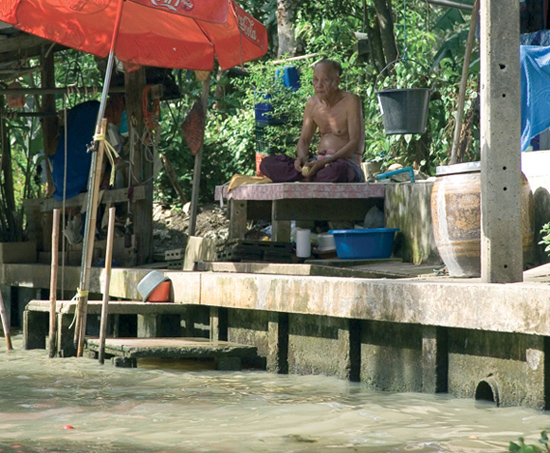
Appreciating the shade at the Damnoen-Saduak floating market.
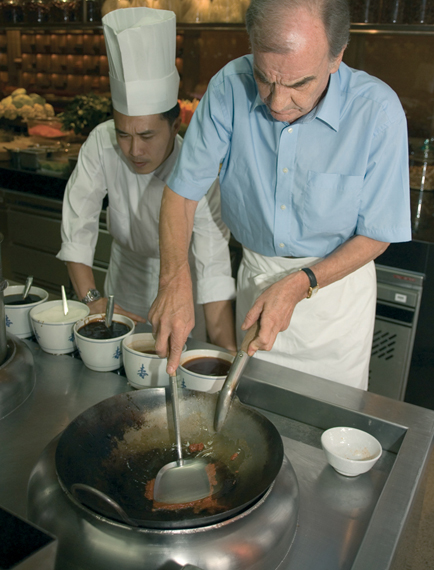
Dry-frying my spices for a curry paste, in the kitchens of the Intercontinental Hotel.
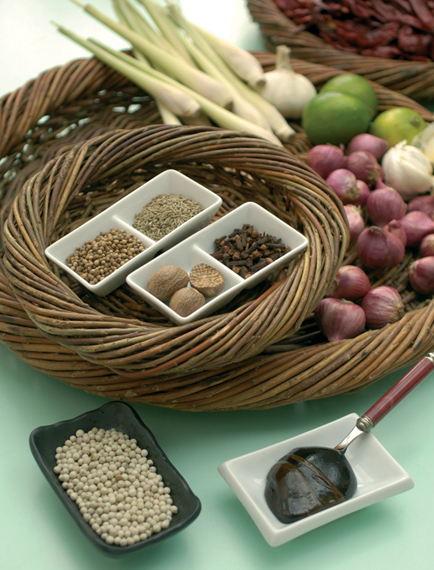
Ingredients for the Thai red curry paste.
The sauces and pastes below are used in recipes throughout the book. The dips, starting on page 51, will all go with kebabs, prawns and finger foods.




